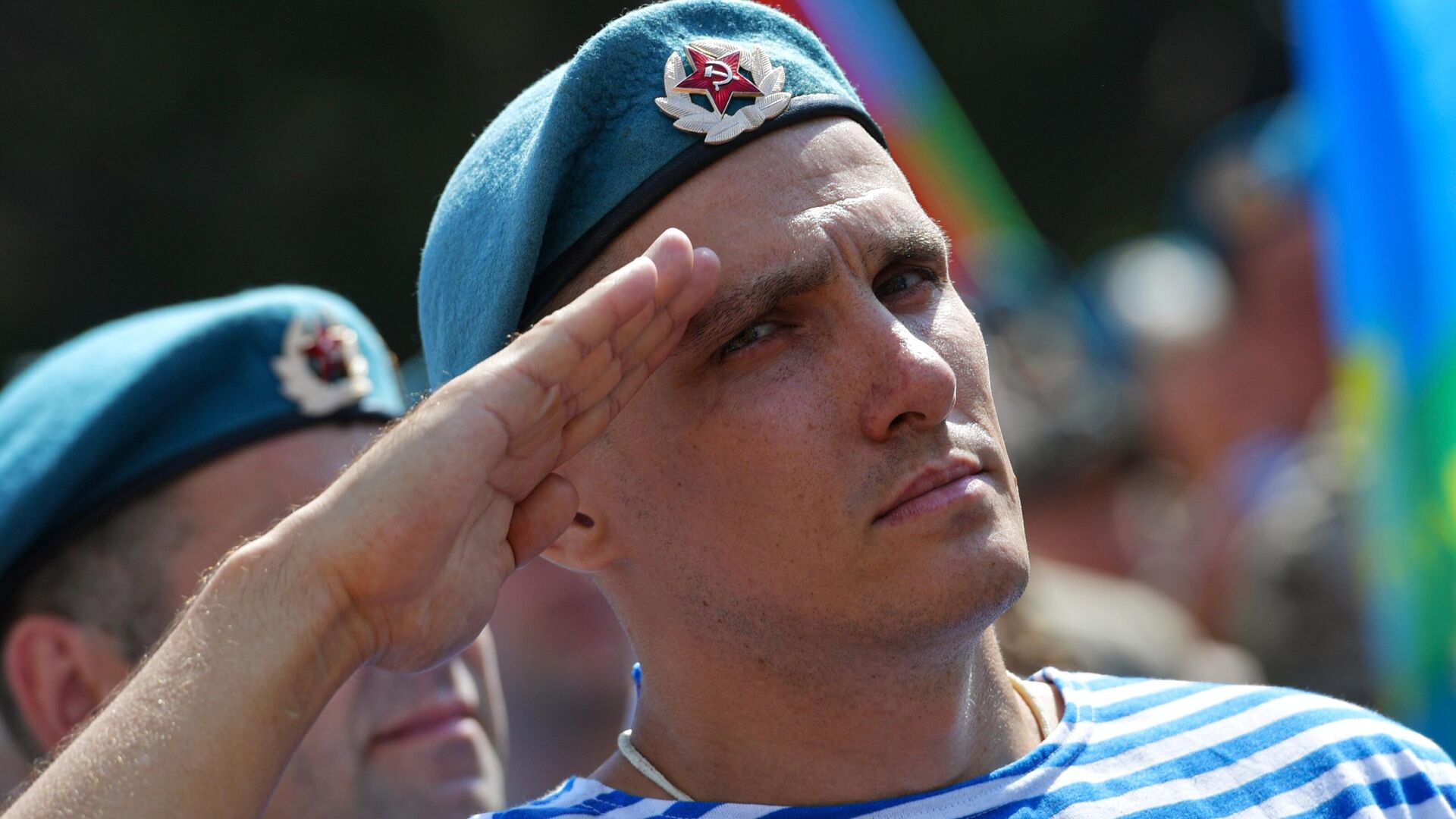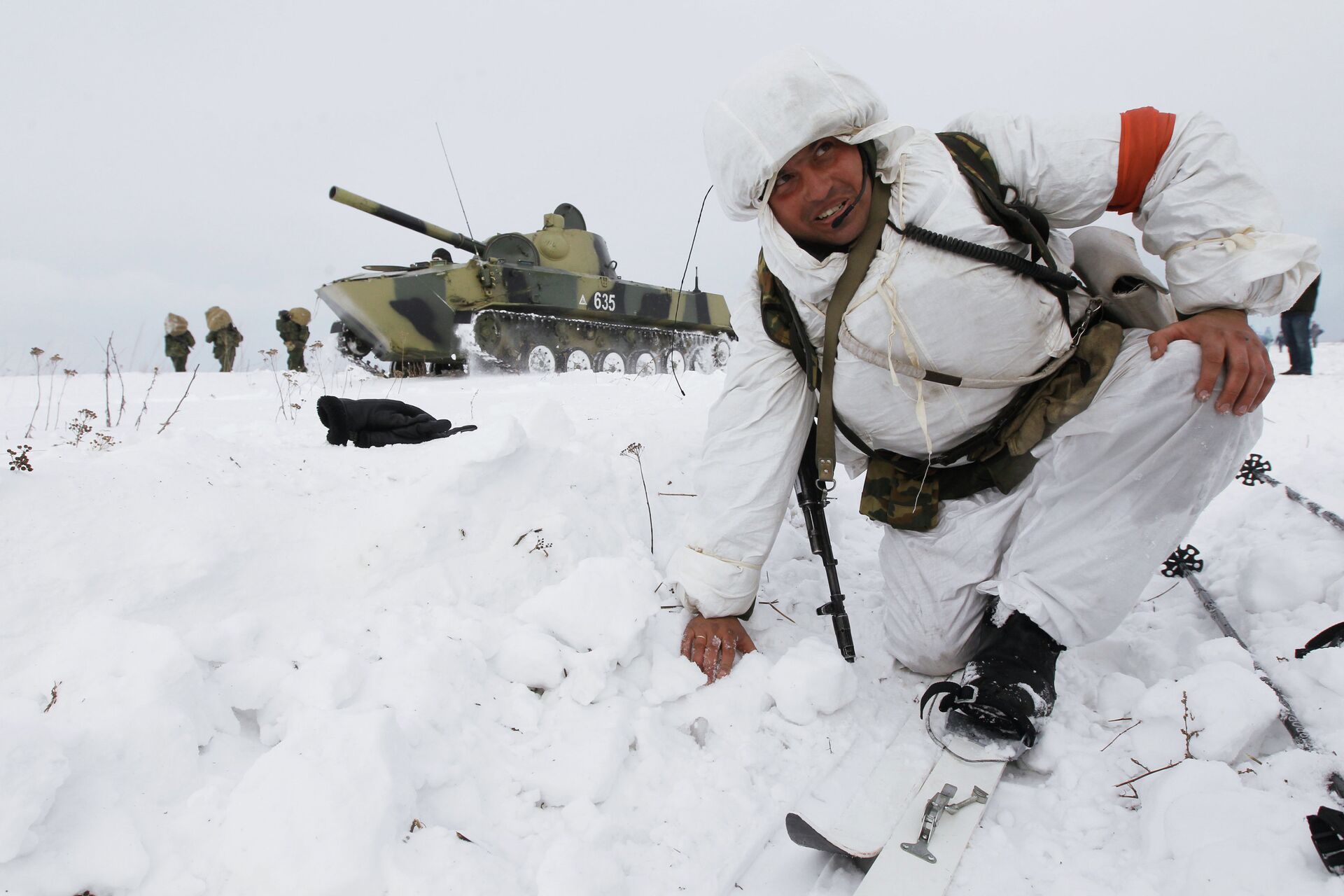https://sputnikglobe.com/20230802/how-russias-airborne-troops-hold-fronts-together-1112350274.html
How Russia's Airborne Troops Hold Fronts Together
How Russia's Airborne Troops Hold Fronts Together
Sputnik International
Wednesday marks Russian Airborne Forces Day, the professional holiday dedicated to Russia’s paratroopers. Sputnik decided to reach out to Soviet and Russian Airborne Forces veteran Major-General (ret.) Oleg Fedyaev for unique insights into Russian paratroopers' critical role in the proxy war with NATO in Ukraine.
2023-08-02T15:01+0000
2023-08-02T15:01+0000
2023-08-02T16:53+0000
military
russia
russia’s airborne forces (vdv)
russian airborne forces
holiday
capabilities
https://cdn1.img.sputnikglobe.com/img/07e7/08/02/1112342912_0:0:3181:1790_1920x0_80_0_0_70db61892df4656c7f30a54f018e8ce8.jpg
Russia’s Airborne Forces, also known by their Russian acronym VDV, were born 93 years ago on August 2, 1930. Since then, this elite branch of the armed forces has been associated with nearly all of the country’s major 20th and 21st century conflicts, from the Battle of Lake Khasan and the Battle of Khalkhin Gol against Japan in 1938 and 1939, to World War II and the Soviet War in AfghanistanIn the post-Soviet period, Russia’s Airborne Forces were again thrown into the heaviest conflicts, fighting in the First and Second Chechen Wars, the 2008 conflict with Georgia, and, from 2022 on, in Ukraine, where they mounted successful operations to capture key airports and airfields around Kiev in March of 2022.Since then, the VDV has been deployed on the ground alongside the regular Russian Army and Donbass People’s Militias, often in the most difficult and dangerous sections of the front."Judging by the information that's available in the open press, they are performing these tasks very successfully," the retired soldier added.Fedyaev said that the Airborne Forces’ "extraordinary fortitude," tenacity, and resilience never cease to amaze him, with the troops proving themselves, for example, in the bloody meat grinder in Artemovsk/Bakhmut, where they helped assure the stability of the flanks, and in so doing the "tactical stability of this entire defense area."Drone Technologies and the Changing Face of Modern WarfareFedyaev emphasized that as the cream of the crop of the Russian Army, the Airborne Troops are equipped with the most modern weapons, gear, and communications equipment, including anti-tank weapons and drones. The latter are used to effect to scope out the enemy at tactical depth, he said."Drones constantly monitor the situation, they see the entire tactical zone in real time. They transmit this information – target coordinates, enemy movements, also in real time…This makes it possible to draw conclusions not only about where the enemy is and to hit him, but about his plans, where he wants to move, where he is concentrating forces, what he intends to do in the next two, three or four days. All this is revealed instantly. And of course, decisions are made then and there, in real time."Russia's VDV vs. Foreign Airborne FormationsFedyaev said that independent of whatever biases he may have as a veteran of the Russian Airborne Forces, they truly can be characterized as the best paratrooper forces in the world, both historically and in the present.“After that, I analyzed the tragic landings – there were several of them, by our paratroopers near Moscow during the winter of 1941, where our troopers distinguished themselves, perished there, but delayed [the Nazis’] immensely powerful blow to Moscow,” Fedyaev recalled.“Starting from those times and analyzing the further performance of the airborne forces of the world, I will tell you that we are not just one of the best – but the best, and by a lot,” Fedyaev emphasized. “For example, not a single American special operation involving the landing of troops has achieved significant success,” with their entire history filled with “blunders.”In Fedyaev’s estimation, the only other airborne forces with capabilities which can be compared to Russia’s are those of the Korean People’s Army and their 88,000-troop strong Special Purpose Forces Command.Fedyaev stressed that the Ukrainian Army which the Russian military and the Airborne Forces met in 2022 was “the strongest in Europe,” besides Russia. “It really was a very serious military monster that they [NATO, ed.] managed to raise. They were well prepared both quantitatively and qualitatively…Today, the Ukrainian Army is spent, although it still has some potential, of course,” the retired major-general summed up.
russia
Sputnik International
feedback@sputniknews.com
+74956456601
MIA „Rosiya Segodnya“
2023
News
en_EN
Sputnik International
feedback@sputniknews.com
+74956456601
MIA „Rosiya Segodnya“
Sputnik reports from the training site of the elite 106th Guards Airborne Division as the country celebrates Airborne Forces Day
Sputnik International
Sputnik reports from the training site of the elite 106th Guards Airborne Division as the country celebrates Airborne Forces Day
2023-08-02T15:01+0000
true
PT1M04S
Sputnik International
feedback@sputniknews.com
+74956456601
MIA „Rosiya Segodnya“
russian airborne forces, holiday, vdv, soviet union, russia, ukraine, great patriotic war, afghanistan, chechnya, elite troops, what is vdv, russian paratroopers, rusian airborne forces, russian elite forces
russian airborne forces, holiday, vdv, soviet union, russia, ukraine, great patriotic war, afghanistan, chechnya, elite troops, what is vdv, russian paratroopers, rusian airborne forces, russian elite forces
How Russia's Airborne Troops Hold Fronts Together
15:01 GMT 02.08.2023 (Updated: 16:53 GMT 02.08.2023) Wednesday marks Russian Airborne Forces Day, the professional holiday dedicated to Russia’s paratroopers. On the occasion, Sputnik decided to reach out to Soviet and Russian Airborne Forces veteran Major-General (ret.) Oleg Fedyaev for unique insights into Russian paratroopers’ critical role in the proxy war with NATO in Ukraine.
Russia’s Airborne Forces, also known by their Russian acronym VDV, were born 93 years ago on August 2, 1930. Since then, this elite branch of the armed forces has been associated with nearly all of the country’s major 20th and 21st century conflicts, from the Battle of Lake Khasan and the Battle of Khalkhin Gol against Japan in 1938 and 1939, to World War II and the Soviet War in Afghanistan
In the post-Soviet period, Russia’s Airborne Forces were again thrown into the heaviest conflicts, fighting in the First and Second Chechen Wars, the 2008 conflict with Georgia, and, from 2022 on, in Ukraine, where they mounted successful operations to capture key airports and airfields around Kiev in March of 2022.
Since then, the VDV has been deployed on the ground alongside the regular Russian Army and Donbass People’s Militias, often in the most difficult and dangerous sections of the front.
"In principle, paratroopers are designed to land behind enemy lines and perform tasks in the rear. But in the current situation in the special operation zone, since landings are not currently planned, the Airborne Forces troops are performing tasks at junctions, on the flanks and in critical areas where the danger of the penetration of enemy troops is greatest," Major-General Fedyaev told Sputnik.
"Judging by the information that's available in the open press, they are performing these tasks very successfully," the retired soldier added.
Fedyaev said that the Airborne Forces’ "extraordinary fortitude," tenacity, and resilience never cease to amaze him, with the troops proving themselves, for example, in the bloody meat grinder in Artemovsk/Bakhmut, where they helped assure the stability of the flanks, and in so doing the "tactical stability of this entire defense area."
"The paratroopers simply work wonders with small numbers…It’s amazing how such small forces are able to contain such onslaughts, their efforts are worth a great deal. I am amazed by the transfer of this wonderful tradition of resilience [from one generation to another]," Fedyaev said, referring to the VDV’s "Nobody, But Us!" motto and "not one step back" mentality.
Drone Technologies and the Changing Face of Modern Warfare
Fedyaev emphasized that as the cream of the crop of the Russian Army, the Airborne Troops are equipped with the most modern weapons, gear, and communications equipment, including anti-tank weapons and drones. The latter are used to effect to scope out the enemy at tactical depth, he said.
"Drones constantly monitor the situation, they see the entire tactical zone in real time. They transmit this information – target coordinates, enemy movements, also in real time…This makes it possible to draw conclusions not only about where the enemy is and to hit him, but about his plans, where he wants to move, where he is concentrating forces, what he intends to do in the next two, three or four days. All this is revealed instantly. And of course, decisions are made then and there, in real time."
Russia's VDV vs. Foreign Airborne Formations
Fedyaev said that independent of whatever biases he may have as a veteran of the Russian Airborne Forces, they truly can be characterized as the best paratrooper forces in the world, both historically and in the present.
“My diploma project [at the academy, ed.] was on airborne assaults and the corresponding forces and means in the world generally. In other words, I carried out an analysis of which forces were worth what during the Second World War. This included the landings at Normandy, where the British 6th Airborne Division performed flawlessly, it’s worth saying. And where two American divisions – the 101st and 82nd Airborne, performed disgracefully, in my opinion and according to my analysis,” the retired officer said.
“After that, I analyzed the tragic landings – there were several of them, by our paratroopers near Moscow during the winter of 1941, where our troopers distinguished themselves, perished there, but delayed [the Nazis’] immensely powerful blow to Moscow,” Fedyaev recalled.
“Starting from those times and analyzing the further performance of the airborne forces of the world, I will tell you that we are not just one of the best – but the best, and by a lot,” Fedyaev emphasized. “For example, not a single American special operation involving the landing of troops has achieved significant success,” with their entire history filled with “blunders.”
Secondly, he said, Russia’s paratroopers are distinguishable by their unusually large size, with their heavy weapons enabling them to enjoy not only a quantitative, but qualitative edge. “No one had airborne combat vehicles, fire support means, before us. We got them thanks to [legendary Soviet VDV commander Vasily] Margelov. What kinds of paratroopers could think of armored combat vehicles deployed by parachute? Yes, they [other airborne forces] are children compared to us.”
In Fedyaev’s estimation, the only other airborne forces with capabilities which can be compared to Russia’s are those of the Korean People’s Army and their 88,000-troop strong Special Purpose Forces Command.
“Their training is excellent. That’s who I can mention as comparable. But besides that, the Americans – nope, the British are long gone, although at one time they were excellent. As for the French, their Foreign Legion has always been more active in this regard, and a parachute regiment exists as part of the Foreign Legion. They were more or less well-prepared. As for the regular troops? Nope.”
Fedyaev stressed that the Ukrainian Army which the Russian military and the Airborne Forces met in 2022 was “the strongest in Europe,” besides Russia. “It really was a very serious military monster that they [NATO, ed.] managed to raise. They were well prepared both quantitatively and qualitatively…Today, the Ukrainian Army is spent, although it still has some potential, of course,” the retired major-general summed up.







